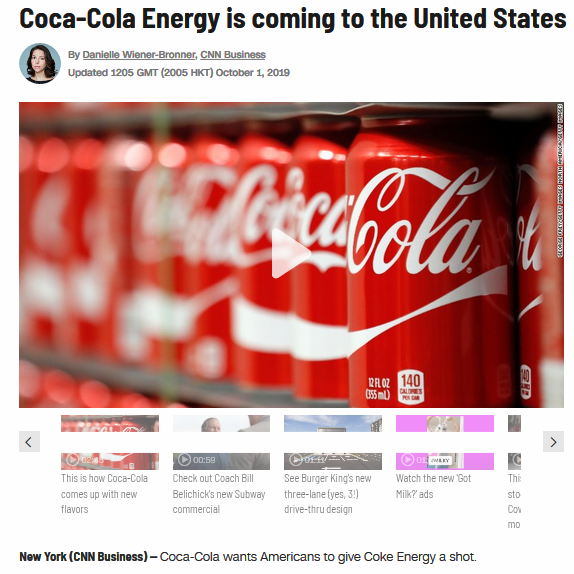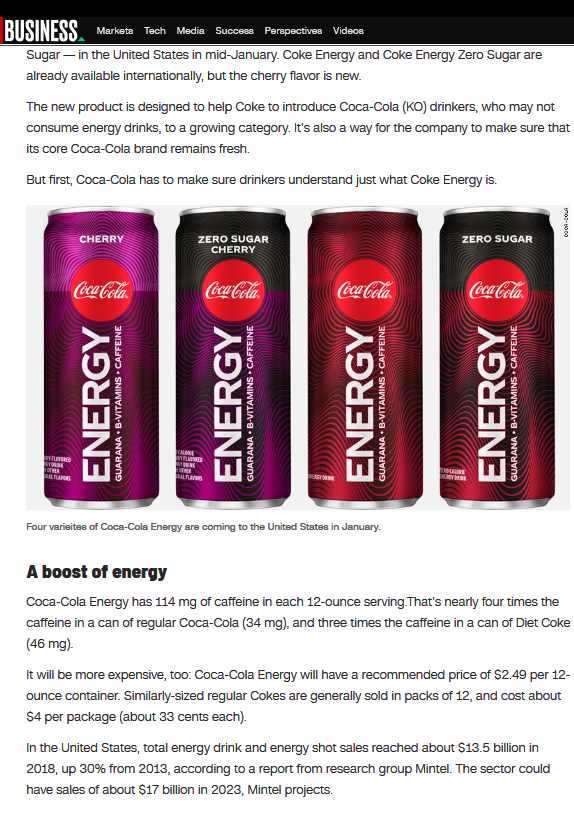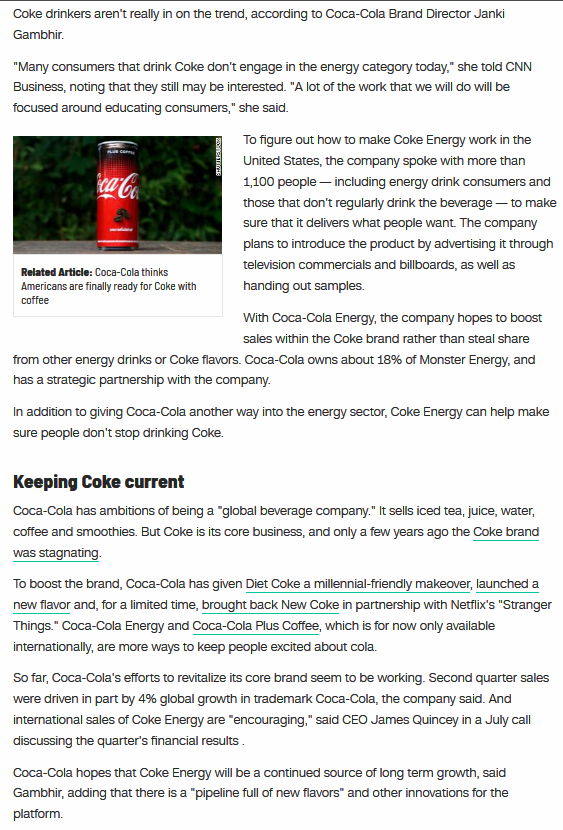Summary of the News Story One
Aldi’s Christmas advertisement presented in 2019 was declared as the most effective marketing campaign in comparison to other brands. The advertisement depicted Kevin the Carrot as the well-known mascot of the brand participating in the show (see Appendix A). The effectiveness and success of advertisements were evaluated according to eight criteria, such as brand building, brand love, emotionality, differentiation, being “Christmassy”, catching attention, being enjoyable, being remembered (Vizard, 2019). The data were collected and analyzed by Kantar, and Aldi’s advertising was discussed as most effective according to four criteria out of eight that will lead the target audience to sales. In order to form this pool of data, 3000 potential customers were interviewed by Kantar researchers (Vizard, 2019). Among the competitors of Aldi in terms of Christmas advertising, the following brands were named as successful in the UK: M&S Food, Tesco, Ikea, and Amazon.
Analysis of Marketing Principles and Practices Related to Aldi’s Christmas Advertising Campaign
Introduction
Aldi is a German retailer, and this supermarket chain was founded in 1946. Currently, the chain is represented by discount supermarkets in about 20 countries all over the globe, having more than 10,000 stores (Brandes and Brandes, 2019). In 2019, Aldi’s Christmas advertisement representing Kevin the Carrot in the show was named to be the most successful one in the United Kingdom according to the data of Kantar (Appendix A; Vizard, 2019). It is important to focus on the analysis of this marketing-related story to understand what approaches helped Aldi to become successful. The success of Aldi’s Christmas marketing campaign should be viewed as reasonable as the development of the advertisements was based on targeting the audience and improving the brand image of the company.
Aldi’s Brand Positioning
The message of Aldi’s Christmas marketing campaign representing Kevin the Carrot overcoming troubles and singing in the show complies with the company’s overall positioning. Thus, Aldi’s positioning is based on offering products of high quality at comparably low prices, and Aldi stores are promoted as having the cheapest prices in the market (Brandes and Brandes, 2019). The accessibility of the assortment in stores and the choice of this brand to prepare dishes for Christmas are accentuated with the help of demonstrating products sold by the retailer most attractively and vividly. Showstoppers used in the campaign of 2019 also contributed to creating the image of the store with the most attractive and competitive prices, demonstrating available discounts for high-quality products (McGonagle, 2019). As a result, while referring to the brand positioning as the most economical retail store, Aldi accentuated the reasonability of choosing their products for spending holidays.
Target Audience and Customer Relationships
The development of an effective advertising campaign to be used during the holidays depends on the determination of the target audience. Referring to the campaign “Put on an amazing show this Christmas,” the target audience is represented not only by those 25-65 female and male customers who belong to the middle-income group and prefer shopping in Aldi stores but also by young people preferring different types of entertainment (McGonagle, 2019; Vizard, 2019). The use of cinematographic effects and the focus on the elements of the show attract more potential customers among the public that was not targeted previously.
The advertising objectives were to build stronger positive relationships with existing and new customers. The reference to the previously featured character of Kevin the Carrot is oriented toward those customers who demonstrate their loyalty to the brand. The usage of the elements of the show and films demonstrated on TV allows for attracting more potential consumers who traditionally choose spending holiday evenings in front of the TV set with their families (Dibb et al., 2019; Wierenga and Van der Lans, 2017). The demonstration of prices with discounts for the most popular products during holidays that are observed in showstoppers is oriented toward this cluster of potential customers.
AIDA Model and Communications Effects of the Advertisements
Advertising using the TV channel is one of the key components in the promotional mix to guarantee the recognition of the brand or products among the public. The success of Aldi’s advertising campaign in such categories as brand building, differentiation, and emotional arousal is based on adopting the AIDA (attention, interest, desire, and action) sequence when developing the advertisement and showstoppers (Figure 1). The AIDA model is defined as a tool that helps to represent the hierarchy of effects on consumers to lead them from the awareness of the product or attention to it, the interest, and the desire buy to the action of purchasing (Daabes and Adballa, 2016). The AIDA complex is important for any advertisement as it is targeted to the audience and potential customers.

The analyzed advertisement representing Kevin the Carrot participating in the Aldi show attracts the TV audience’s attention with the help of filming the story of Kevin the Carrot, who needs to oppose Russell Sprout or “a bad guy” to join the show. The authors of the advertisement used recurring characters to stimulate viewers’ interest as they are familiar with other Aldi advertisements (McGonagle, 2019). The key focus is on using the popular character in advertisements that can be associated with potential customers’ positive memories.
The interest is developed at the stage of recognizing the voice and song of Kevin the Carrot as the voice and song of Robbie Williams, who performed the changed version of his track in the context of Aldi’s campaign (McGonagle, 2019). The next stage of the persuasive cycle is to provoke the desire to buy products at Aldi stores, and the images of festive tables as the stage for the show, along with showstoppers demonstrating the assortment, contribute to this goal (Baker and Hart, 2016; Dibb et al., 2019). The final stage is associated with provoking the action, and the prior three steps were developed to make the audience interested in the advertisement to visit Aldi’s stores because of the presented assortment of products and attractive discounts. The necessity of catching the target audience’s attention through the AIDA sequence explains the necessity of making advertisements as creative as possible.
The success of Aldi’s advertisement among the public should also be analyzed in the context of important communications effects that include the category need, the brand awareness and attitude along with the brand purchase intention, as well as the purchase facilitation. The category need for Aldi’s assortment is created through representing their assortment in the form of a creative film-like advertisement (Fill and Turnbull, 2016). As it was stated by customers, the advertisement also helped to form brand awareness, and its emotionality and the holiday atmosphere created a positive brand attitude (Vizard, 2019). These effects were achieved through creating an emotionally appealing advertisement involving the well-known character Kevin the Carrot and Robbie Williams as a celebrity drawing the public’s attention to the advertisement (McGonagle, 2019). The known melody of a popular song contributes to creating the association between positive memories and Aldi’s brand.
The key focus is also on using this warm, emotional, and enjoyable advertisement as attracting the public’s attention to Aldi’s products and contributing to the brand purchase intention. The final desired effect is the purchase facilitation that is realized with the help of informing the audience about discounts that work during the holiday period (Dibb et al., 2019). However, the discussed advertisement played an important role in forming such three effects as forming the category need, brand awareness, and brand attitude. The impact on the brand purchase intention and purchase facilitation is realized through combing more elements of the marketing campaign of Aldi, including the advertising component.
Conclusion
The detailed marketing analysis of Aldi’s Christmas advertising campaign of 2019 presenting the advertisement and showstoppers indicates that the marketers were interested in contributing to brand awareness and forming a favorable attitude. Even if Christmas advertisements may not lead to direct purchasing products at Aldi stores, this marketing campaign has contributed to strengthening brand awareness and recognition. Furthermore, it has contributed to building longer positive relationships with consumers because of their positive attitude to the Aldi brand associated with their memories about the holidays. Being attractive and provoking positive feelings, the advertisement representing Kevin the Carrot and the Aldi show caught the attention of different segments of the target audience. This success of the advertising campaign can potentially lead to increased sales.
Summary of the News Story Two
In 2019, Coca-Cola planned to launch Coca-Cola Energy in the US market after introducing this new product in Europe and other countries. This new product from the category of energy drinks was planned to be promoted in four varieties (Coca-Cola Energy, Coca-Cola Energy Cherry, Coca-Cola Energy Zero Sugar, Coca-Cola Energy Cherry Zero Sugar) (see Appendix B). According to the author of the article, the main goal of Coca-Cola was not to start the competition in the market of energy drinks but to attract more attention to Coca-Cola’s core products (Wiener-Bronner, 2019). Coca-Cola Energy has more doses of caffeine in one portion, and this product is distributed as more expensive than other Coca-Cola products. The company is interested in entering the US market because energy drinks are actively sold in the United States, and the company is also interested in attracting customers via a new product.
Analysis of Marketing Principles and Practices Related to Coca-Cola’s Launching a New Product
Introduction
The Coca-Cola Company is one of the leading manufacturers of non-alcoholic beverages in the world. It was founded in 1892, and it remains to be a popular brand of different types of drinks and syrups. However, the current interest of the public in reducing the consumption of sugars and sweet beverages makes Coca-Cola and its competitors develop and launch new attractive products to stimulate brand popularity and sales (Wu, 2019). In 2019, the Coca-Cola Company announced the launching of Coca-Cola Energy in Europe (the United Kingdom, Germany, and Spain) and then in the United States (Appendix B; Wiener-Bronner, 2019). The Coca-Cola Company’s goal to develop its product portfolio with the help of Coca-Cola Energy beverages should be regarded as an effective strategy to enter a new market segment and attract more new customers interested in purchasing energy drinks.
Market Segmentation
The specifics of launching Coca-Cola Energy in the US market are determined by the company’s approach to market segmentation. The first step in this process is the identification of certain market segments or groups of customers to focus on according to base and descriptor variables (Dibb et al., 2019). For this new product, the target audience is represented by predominantly young male and female individuals who follow an active lifestyle and often purchase beverages, focusing on energy drinks. The second step is targeting the identified segments with the help of starting marketing activities.
In this context, the information about launching Coca-Cola Energy in the European and US markets is the realization of the second step when potential customers can demonstrate their interest in this new product. The third step is positioning with the help of a unique image. The main information that will be advertised by Coca-Cola is that their new beverage has a large dosage of caffeine, which can potentially boost a drinker’s energy (Wiener-Bronner, 2019). Furthermore, the product’s flavors are unique in comparison to other brands because they will be preferred by those customers who want energy drinks to have the Coca-Cola taste.
Ansoff’s Matrix and Coca-Cola’s Strategy
Ansoff’s product-market matrix was developed to determine the most effective marketing strategy for a company to follow and achieve success (Figure 2). The four competitive strategies that are identified regarding Ansoff’s matrix are market penetration, market development, product development, and diversification. The market penetration strategy is associated with promoting existing products in present markets. Market development is based on promoting existing products in new markets (Dibb et al., 2019; Yin, 2016). Product development is observed when a company introduces new products in present markets, and diversification is associated with promoting new products in new markets.
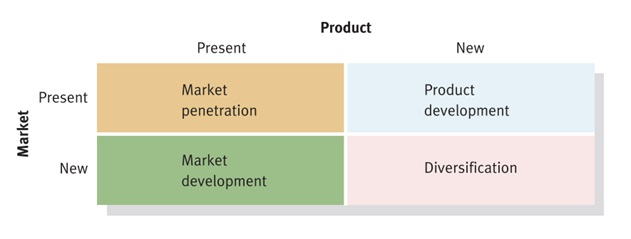
The launching of Coca-Cola Energy in the US market of energy drinks is associated with the strategy of diversified growth. Diversification realized by the Coca-Cola Company depends on the development of Coca-Cola Energy as a new product in their product line. The market of energy drinks can also be discussed for the company as new although the company owns nearly 18% of their partner Monster Energy (Taylor, 2019). In this context, the diversification that is planned by the Coca-Cola Company can be described as concentric diversification (Dibb et al., 2019). The reason is that the development and marketing of Coca-Cola Energy are based on the technologies used for the production and promotion of other beverages manufactured on the company, but this product is introduced in a specific new marker of energy drinks. This strategy was selected by the company in contrast to horizontal and conglomerate diversification approaches.
The differential advantage for the Coca-Cola Company in the situation of launching Coca-Cola Energy is the fact that the company has high levels of brand recognition, loyalty, and popularity. The introduction of a new product in the market of energy drinks will attract potential customers’ attention because of their knowledge of Coca-Cola as a high-quality product (Dibb et al., 2019; Zeithaml et al., 2020). From this perspective, the marketers of the company can target not only the fans of Coca-Cola products but also the drinkers of energy beverages. As a result, this strategy can potentially lead to provoking new customers’ interest in traditional Coca-Cola products.
Consumers’ Buying Behavior and the Pricing Strategy
The decision-making process of consumers includes several steps, such as the recognition of the problem, searching for information on possible solutions, evaluating available options for purchasing, the selection of products, and the further assessment of the experience. For those individuals who identify the need for drinking an energy beverage, the decision-making process can be short, and much attention is paid to selecting the beverage among a variety of options (Armstrong et al., 2018). At this stage, the brand popularity typical of Coca-Cola can work as a significant factor to influence a consumer buying intention and behavior. For the case of Coca-Cola Energy, it is possible to observe the routine response behavior as one of the types of consumers’ response behaviors. This type of behaving is typical for purchasing low-cost items, the selection of which does not depend on searching the market.
As a result, it is important to note that brand popularity plays a key role in affecting potential consumers’ choices. Coca-Cola’s differentiation significantly depends on effective branding that allows consumers to choose Coca-Cola products among others because of their loyalty and the possibility to easily determine the preferred products. The familiarity with other Coca-Cola products can make consumers choose their distinctive energy drink (Doole and Lowe, 2019). Furthermore, this relationship can also be observed when discussing customers’ increased interest in Coca-Cola traditional beverages as a result of launching and promoting Coca-Cola Energy.
It is stated that the routine response behavior is characteristic for low-cost items, and it is important to focus on the pricing strategy determined for Coca-Cola Energy. Setting the price for Coca-Cola Energy, it was important for marketers to determine the range average for the market. For the US market, the recommended price per 12-ounce container is $2.49 that is an average price in the market of energy drinks (Wiener-Bronner, 2019). There is also the possibility that the price will rise after the successful launching of Coca-Cola Energy. The currently observed pricing strategy is based on attracting more brand-led consumers to the product and demonstrating its accessibility (Dibb et al., 2019). This selection of the price is based on assessing the following factors: the target audience’s perception of the price and competitors’ prices.
Conclusion
The analysis of the news related to Coca-Cola’s launching of Coca-Cola Energy has allowed for concentrating on some aspects of marketing. They include segmentation, the selection of the marketing strategy, the focus on consumers’ buying behavior, and the pricing strategy. After determining the target audience and the market segment for a new product, it was important for the Coca-Cola Company to develop a plan of action depending on a certain marketing strategy. For the case of Coca-Cola Energy, the most appropriate marketing strategy is diversification based on the principles of concentric diversification for launching a new product in a new market for the company. Brand loyalty and recognition also influence the marketing actions associated with predicting consumers’ buying behavior and determining the pricing strategy. When referring to the analysis of the discussed marketing situation, it is possible to expect that drinkers of energy beverages will choose Coca-Cola Energy because of their familiarity with this company and its other products.
Reference List
Armstrong, G.M. et al. (2018) Marketing: an introduction. London: Pearson UK.
Baker, M.J. and Hart, S. (2016) The marketing book. London: Routledge.
Brandes, D. and Brandes, N. (2019) Bare essentials: The ALDI story. Wien: Linde Verlag GmbH.
Daabes, A.A. and Adballa, A. (2016) ‘AIDA marketing communication model: vehicles running on Liquid Natural Gas (LNG) in the mind of UAE customers’, International Journal of Marketing and Technology, 6(9), pp.117-127.
Dibb, S. et al. (2019) Marketing, concepts and strategies. 8th edn. Andover: Cengage.
Doole, I. and Lowe, R. (2019) International marketing strategy: analysis, development and implementation. Andover: Cengage.
Fill, C. and Turnbull, S. (2016) Marketing communications. 7th edn. Harlow: Pearson.
McGonagle, E. (2019) ‘Robbie Williams is a singing carrot in Aldi’s Christmas ad’, Campaign, Web.
Taylor, K. (2019) ‘For the first time ever, Coca-Cola will launch a Coke drink that isn’t a soda across America’, Business Insider, Web.
Vizard, S (2019) ‘Aldi crowned this year’s most effective Christmas ad’, The Marketing Week, Web.
Wiener-Bronner, D (2019) ‘Coca-Cola Energy is coming to the United States’, CNN Business, Web.
Wierenga, B. and Van der Lans, R. (2017) Handbook of marketing decision models. New York: Springer.
Wu, J. (2019) ‘Coca-Cola to launch Coke-branded energy drink in US, in a bid for more growth’, CNBC, Web.
Yin, N. (2016) ‘Application of AHP-Ansoff matrix analysis in business diversification: the case of Evergrande Group’, MATEC Web of Conferences, 44, pp. 1-10.
Zeithaml, V.A., et al. (2020) ‘A theories-in-use approach to building marketing theory’, Journal of Marketing, 84(1), pp.32-51.
Appendix A
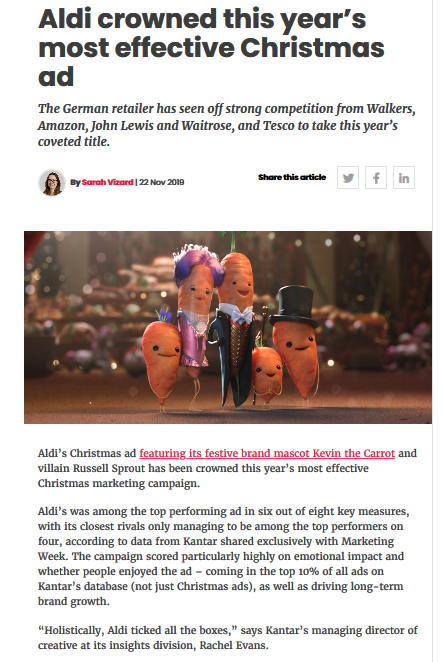
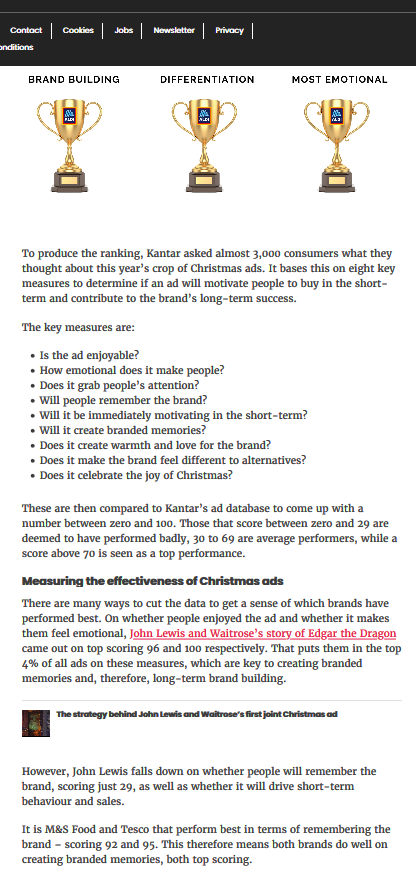
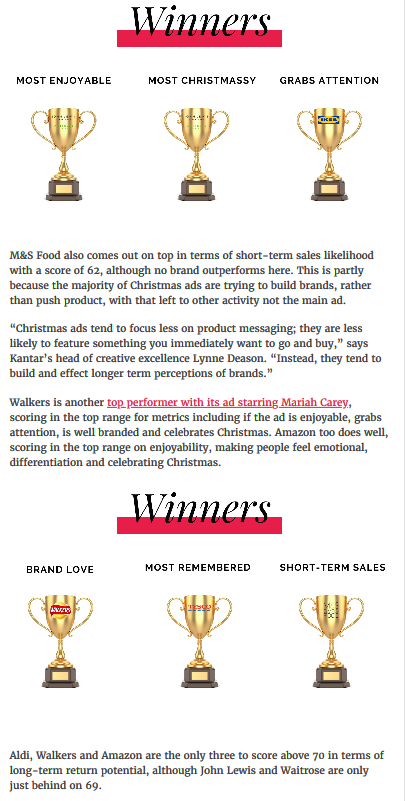

Appendix B
